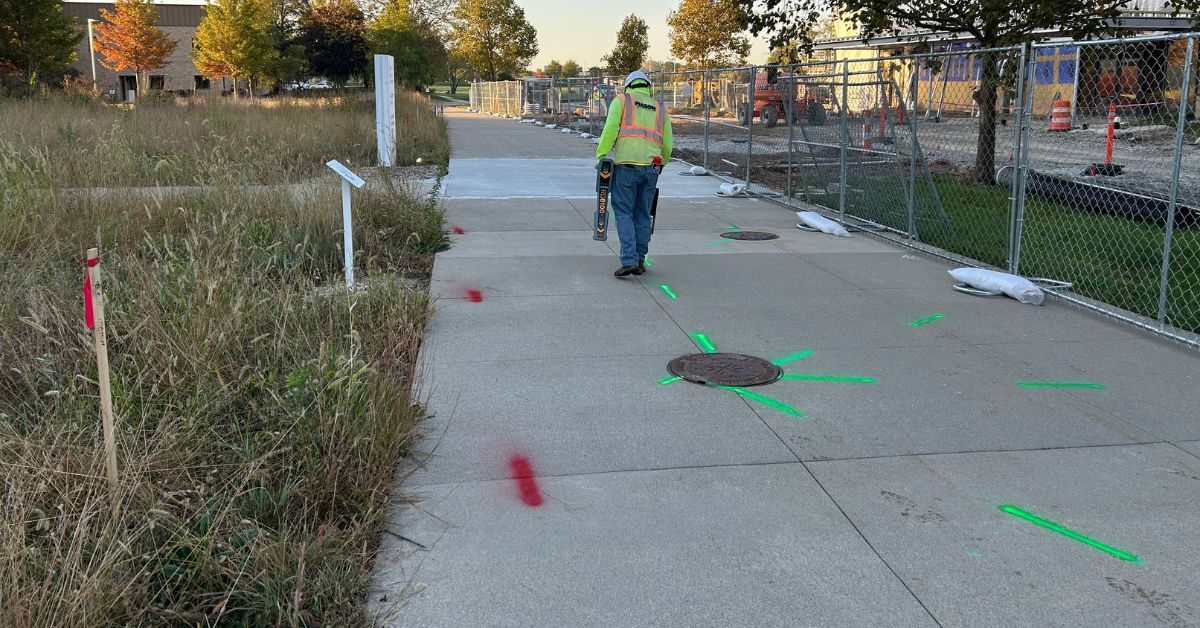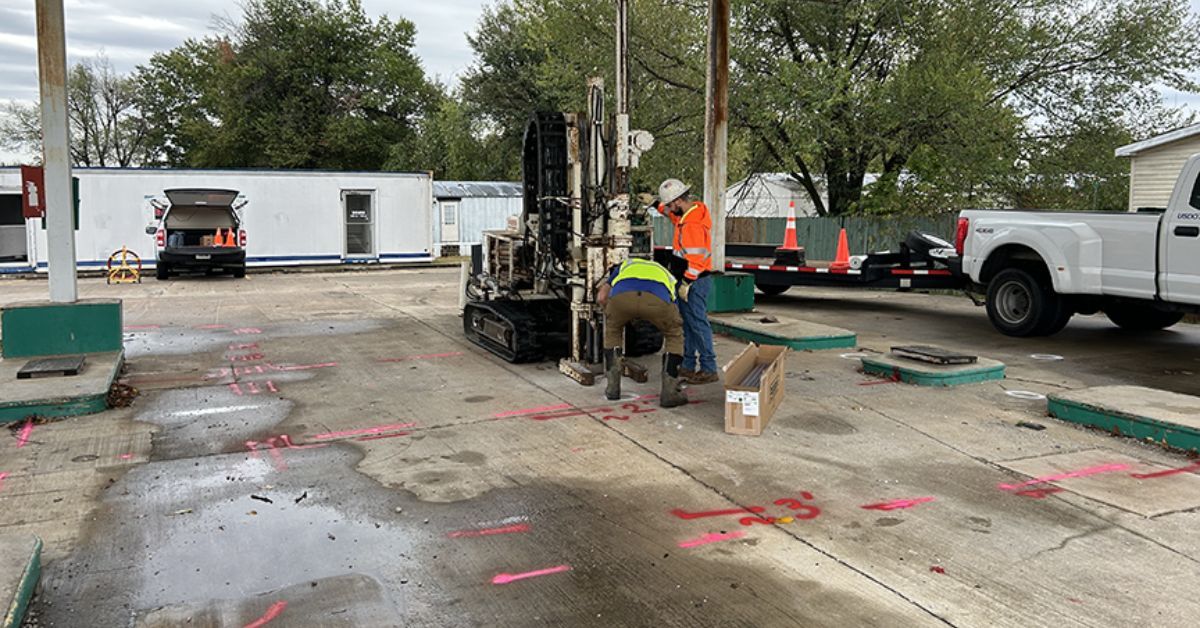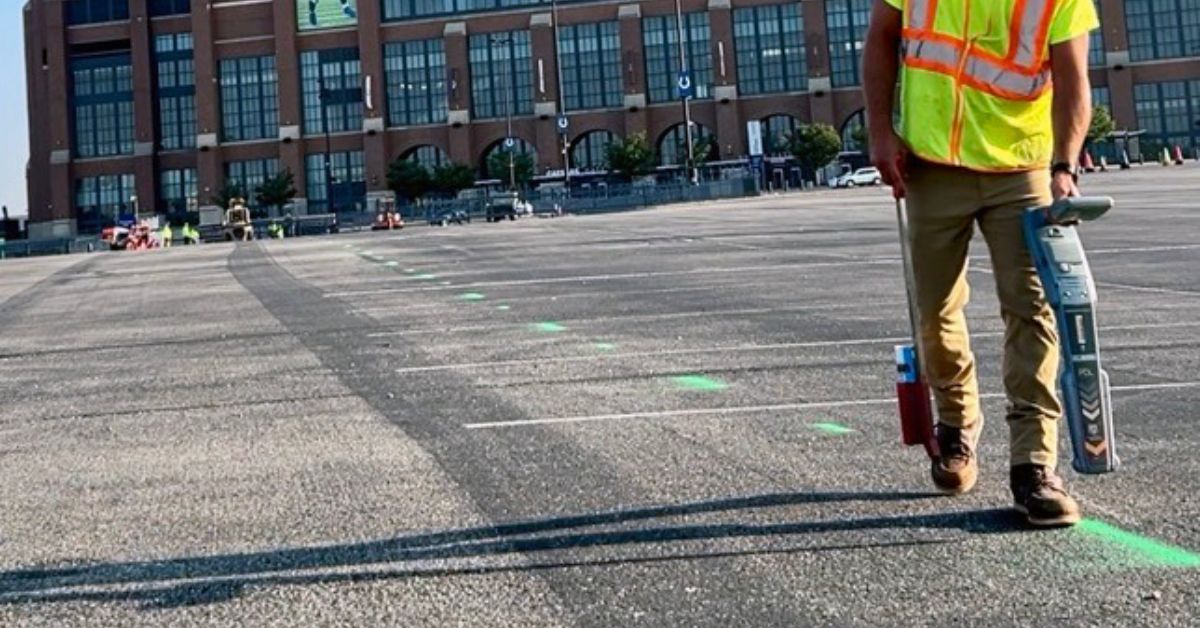
Underground utility strikes cause damage to essential services and pose serious safety risks, making the proper identification of subsurface utilities vital during project planning. The American Public Works Association (APWA) established a standardized color-coding system, to guarantee consistent and clear communication for safe excavation when marking underground infrastructure like gas lines, electrical cables, and water mains.
This uniform system, which utility locators use nationwide, allows construction teams to operate efficiently and avoid costly accidents, regardless of location. This guide will help you understand the many colors of utility line markings.
What are Utility Line Markings?
Utility line markings prevent accidental damage to underground infrastructure during excavation by indicating the approximate location and type of underground utilities. Typically, locators spray paint these markings directly on the ground and include a flag or stake for immediate visibility. These guide construction teams in identifying subsurface services like water, gas, and electrical lines.
Professional utility locating services use advanced tools like ground-penetrating radar and electromagnetic locators to detect buried lines with precision. Beyond marking locations, they provide details such as utility depth, direction, and ownership to guarantee the safe and effective planning of construction projects before the start of any digging.
The APWA Color Code System
The APWA created the uniform color code system to standardize utility marking practices across the U.S. This system assigns specific colors to different utilities, providing a universal language that construction professionals can quickly understand. By offering immediate visual identification of utility types, it eliminates the need for extensive documentation or additional research, helping crews plan excavation activities efficiently.
Professional utility locating companies and private utility locating services strictly follow these color standards for consistency and to prevent confusion on job sites. The system's success relies on its uniform application and universal recognition of color meanings across the construction industry. Now, let's understand more about the colors of utility line markings and what they mean.
Red Markings: Electric Power Lines
Red markings on construction sites indicate electric power lines, cables, conduit, and lighting circuits—some of the most hazardous utilities crews may encounter during excavation. Electric infrastructure includes high-voltage transmission lines, medium-voltage distribution systems, and low-voltage service connections. Contact with energized systems can cause severe injury or death, so crews must exercise extreme caution when working near such lines.
Professional utility locating services help identify the location, voltage, and ownership of electrical infrastructure for safer excavation planning. Electric utilities install their systems at varying depths depending on voltage and local standards—burying high-voltage lines deeper, while keeping residential connections shallower.
Yellow Markings: Gas and Oil Lines
Yellow markings indicate hidden pipelines transporting natural gas, oil, or other flammable materials, which pose considerable safety hazards due to their explosive nature. Accurate identification is a necessity for construction safety as these systems serve residential, commercial, and industrial customers through extensive, pressurized networks.
Utility locating services pinpoint pipeline locations, pressure levels, and materials to support safe excavation planning. Construction crews must follow strict safety protocols near yellow markings, including atmospheric monitoring, special excavation methods, and emergency response procedures.

Orange Markings: Telecommunications Systems
An orange marking means telecommunication infrastructure (telephone lines, fiber optic cables, internet services, cable television systems, etc.) underneath the surface. These systems often include conduits with cable bundles that are buried directly in the soil. Fiber optic cables require careful handling during excavation due to their sensitivity to bending and tension, which can disrupt long-distance signal transmission.
Professional utility locating services use advanced equipment to detect low-voltage signals within these systems, ensuring accurate identification before excavation. The complexity of modern telecommunications networks makes detailed mapping a requirement to avoid damage and to account for all circuits.
Blue Markings: Water Systems
A blue utility marking represents water systems, like service lines, distribution mains, and transmission pipelines that deliver clean water to communities. These utilities require protection during construction to avoid accidental damage. Water systems operate under pressure, and severing a line during excavation can cause flooding, property damage, and service disruptions.
Professional utility locating services use acoustic detection to trace the sound of water through buried pipelines, helping identify water infrastructure. Construction near blue markings requires specific excavation techniques, including hand digging and maintaining clearance distances, to prevent costly repairs and large-scale service outages.
Green Markings: Sewer Systems
A green utility marking will indicate either a sewer or drain system, such as sanitary sewers, storm drains, or combined systems that manage wastewater and stormwater. These systems usually rely on gravity flow and require protection to maintain proper drainage gradients. Utility management typically installs these large-diameter pipes at low depths for adequate cover and flow characteristics.
Utility locators will use cameras and acoustic detection to trace sewer alignments and identify connection points. Construction near green markings must account for the structural integrity of these systems, as ground disturbances can misalign pipes or cause joint separations. Environmental protection also prevents contamination during nearby work.
White Markings: Proposed Excavation Areas
A white marking is slightly different than the rest as it doesn't indicate an active utility but the future excavation area. These markings help utility companies focus their locating efforts on areas where potential conflicts may arise for accurate detection before construction begins.
Utility locating services rely on these boundaries for accurate marking of excavation areas. If excavation extends beyond the marked zones, it may encounter unmarked utilities, leading to safety risks and project delays.
Pink and Purple Markings: Temporary Survey Points
Pink markings indicate temporary survey marks, unknown utilities, or proposed construction elements that require further investigation. Purple markings refer to reclaimed water, irrigation systems, or slurry lines transporting non-potable liquids. These colors signal unique subsurface conditions that fall outside standard utility categories but still require identification during construction planning.
These markings communicate vital information for excavation activities to utility locators. Construction teams must handle pink and purple markings with the same caution as standard utility markings to avoid safety risks or potential project complications.

Importance of Accurate Utility Markings
Accurate utility markings are a necessity for construction site safety and project success. Utility companies must provide precise location data within timeframes, while private utility locating companies, like Mason Private Locating, identify infrastructure standard public services won't cover. Inaccurate markings can cause serious injuries, environmental damage, and costly financial consequences.
Construction projects with incomplete or incorrect utility information face risks such as service disruptions, emergency costs, and legal liabilities. Professional utility locating services are a worthwhile investment, offering a cost-effective way to prevent utility strikes and ensure project safety and success.
When Markings are Unclear or Missing
Construction teams must halt excavation immediately if they encounter unclear, missing, or damaged utility markings and contact the appropriate utility authorities for clarification or additional locating services. Advanced solutions like ground-penetrating radar, vacuum excavation, and other specialized techniques may be necessary in complex cases where standard utility markings fall short. Proceeding with excavation despite questionable utility markings poses liability risks for contractors.
Protecting Lives and Infrastructure Through Proper Identification
Understanding utility line marking colors is a necessity for safe excavation. Beyond recognizing colors, proper utility identification involves understanding depth, service ownership, and coordinating with utility companies.
Professional utility locating services, like Mason Private Locating, can reduce risks, improve timelines, and enhance safety. Protect your team, the public, and critical infrastructure—contact Mason Private Locating today for expert support!













